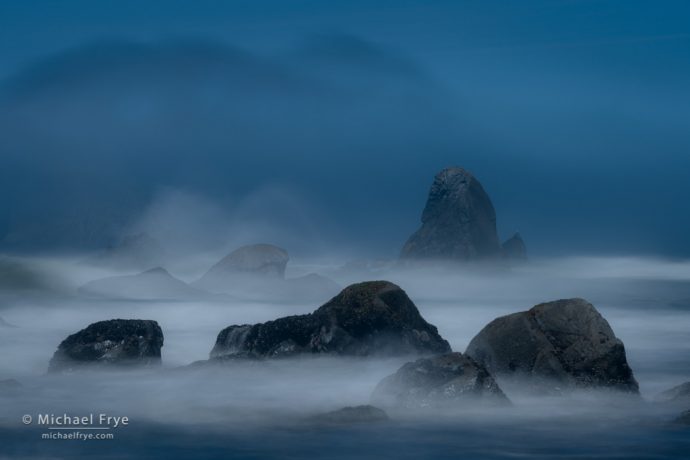
Waves, fog, and sea stacks, northern California coast. High coastal stratus is common along the California coast, but low fog like this is more unusual. I used those conditions to create a soft-on-soft look to this photo, with a six-second shutter speed smoothing out the waves, and the fog obscuring the background. 168mm, 6 seconds at f/16, ISO 100, 7-stop ND filter.
As much as I love the redwood forests, the rugged, rocky coastline of northern California is just as beautiful, and just as essential to the character of this region. You can go from the windy, noisy, wide-open expanses of the coast to the calm, quiet, dense forests in minutes, and the transition is breathtaking. Along many trails through the redwoods you can hear the surf in the distance – while watching the fog roll in off the ocean and into the woods. To me, it’s the close proximity and interaction between the ocean and forests that creates the wonderful, wild mood of this place.
This coastline features innumerable rocks and sea stacks, as the ocean gradually erodes softer rocks, leaving harder rocks stranded offshore. Part of the challenge in photographing these scenes is figuring out where to stand in order to arrange those rocks in a compelling way within the frame.
Another challenge is dealing with the constant movement of the ocean. In addition to the usual landscape-photography variables of weather and light, the tides, wave heights, and wave direction also have a big influence on how a scene looks.
That movement makes shutter speeds more important than with many other landscape subjects, so I’m constantly experimenting with different exposure times in every situation. I often prefer very long exposures (usually requiring strong neutral-density filters) to smooth out the water and add an ethereal look to the photograph. But sometimes a faster shutter speed seems to work better.
Shutter speeds, filters, and camera positions are just part of the photographer’s toolkit, like light, colors, tones, lines, shapes, subjects, timing, and overall composition. Ultimately I’m trying to use all tools at my disposal to capture a little bit of what it feels like to stand along this wild, rugged, rocky coast, watching the waves roll in, hearing the surf, and smelling the salty air.
— Michael Frye
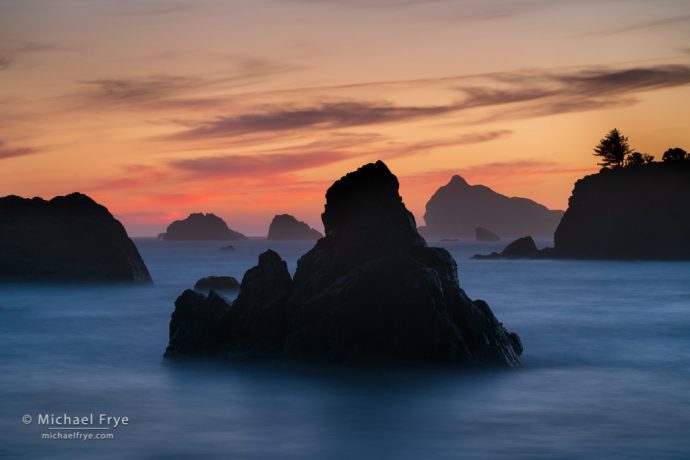
Sea stacks at sunset, Pacific Coast, California. Some high clouds created a pretty, though not spectacular, sunset. I found this arrangement of sea stacks against one particularly colorful patch of clouds, and used a 30-second exposure to smooth out the water. 141mm, 30 seconds at f/8, ISO 100, 7-stop ND filter.
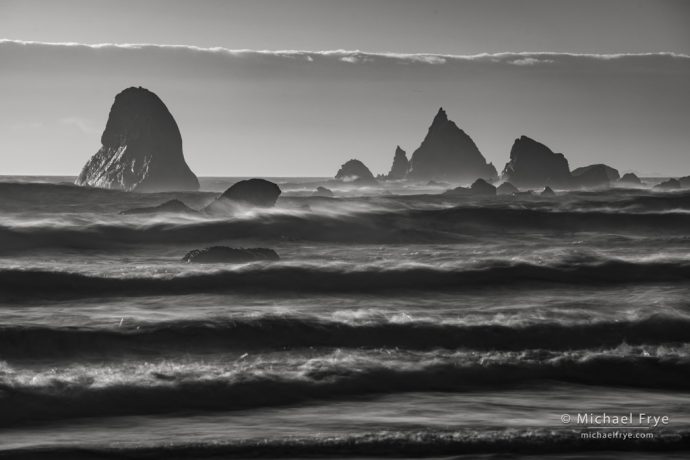
Waves and sea stacks, northern California coast. I liked the lines of waves in this scene, so used an in-between shutter speed of 0.7 seconds – fast enough to preserve the shapes of the waves, but slow enough to soften the waves slightly and create a sense of motion. 200mm, 0.7 seconds at f/11, ISO 100, 4-stop ND filter.
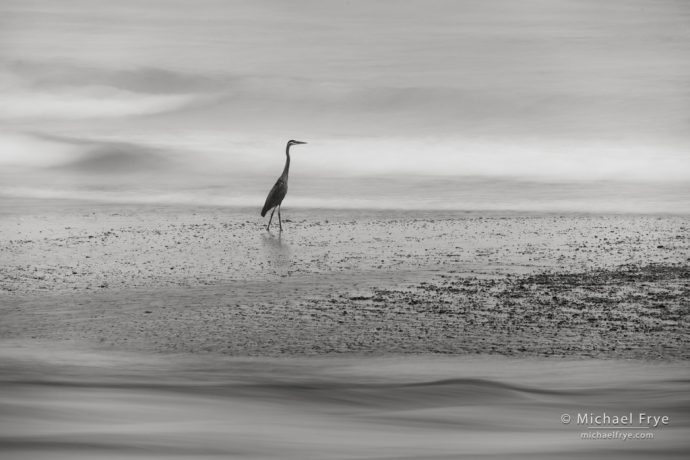
Great blue heron on the beach. Watching herons fishing at this river-mouth beach, I decided to try to use a slow shutter speed to blur the waves, while still keeping the heron sharp. This had a chance of working only because herons often stand perfectly still, but it was still a challenge, and I threw out many frames because the birds moved and became blurred. But a number of images were sharp, including this one. 400mm, 2 seconds at f/16, ISO 160, 4-stop ND filter.
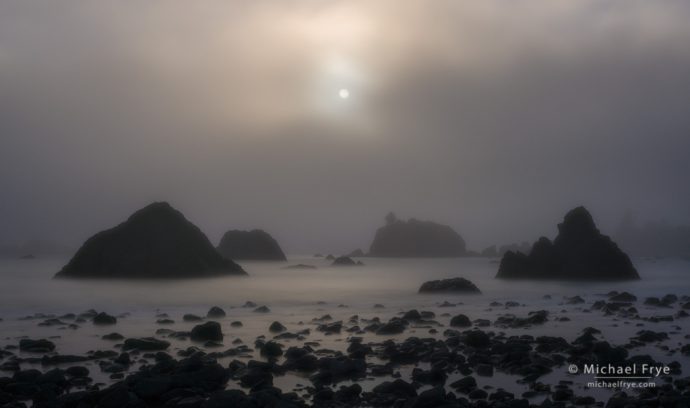
Foggy sunset along the northern California coast. A fog bank rolled in late in the day, creating a wonderfully moody scene. I used a 10-stop ND filter to lengthen the shutter speed to 30 seconds without overexposing the clouds around the sun. 50mm, 30 seconds at f/16, ISO 100, 10-stop ND filter.
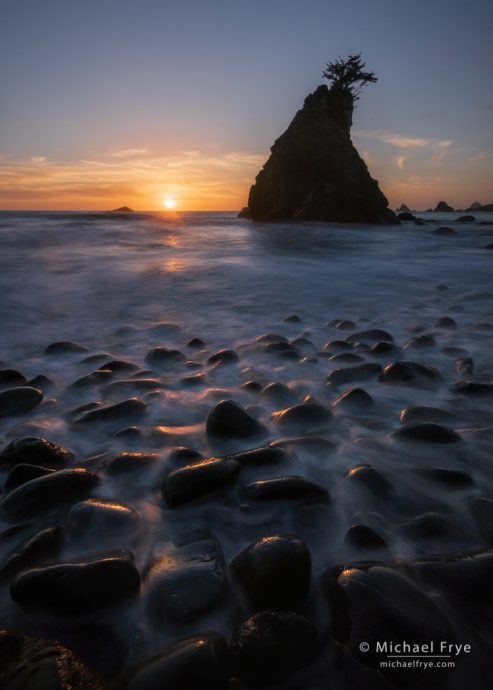
Sea stack and boulders at sunset, California coast. These rounded boulders made a compelling foreground, tempting me to get close to the edge of the water and use a wide-angle lens to include both the boulders and the sea stack. I used a 10-stop ND filter to slow the shutter speed down to 6 seconds, and tried to time my exposures for moments when a wave was receding in order to show the rocks partially covered in water. I had to dodge some of the larger waves, but luckily avoided getting too wet. 18mm, 6 seconds at f/16, ISO 100, 10-stop ND filter.
Related Posts: Return to the Redwoods; Stretching; Chasing Fog
Michael Frye is a professional photographer specializing in landscapes and nature. He is the author or principal photographer of The Photographer’s Guide to Yosemite, Yosemite Meditations, Yosemite Meditations for Women, Yosemite Meditations for Adventurers, and Digital Landscape Photography: In the Footsteps of Ansel Adams and the Great Masters. He has also written three eBooks: Light & Land: Landscapes in the Digital Darkroom, Exposure for Outdoor Photography, and Landscapes in Lightroom: The Essential Step-by-Step Guide. Michael has written numerous magazine articles on the art and technique of photography, and his images have been published in over thirty countries around the world. Michael has lived either in or near Yosemite National Park since 1983, currently residing just outside the park in Mariposa, California.









Michael,
These images are absolutely astounding. Compositions are amazing, using long exposure, and fog elements. Thank you for this helpful post.
Another great set of images Michael! I tried doing a similar thing with a heron and slow shutter speed on the coast a while ago. Love how our minds overlap:)!